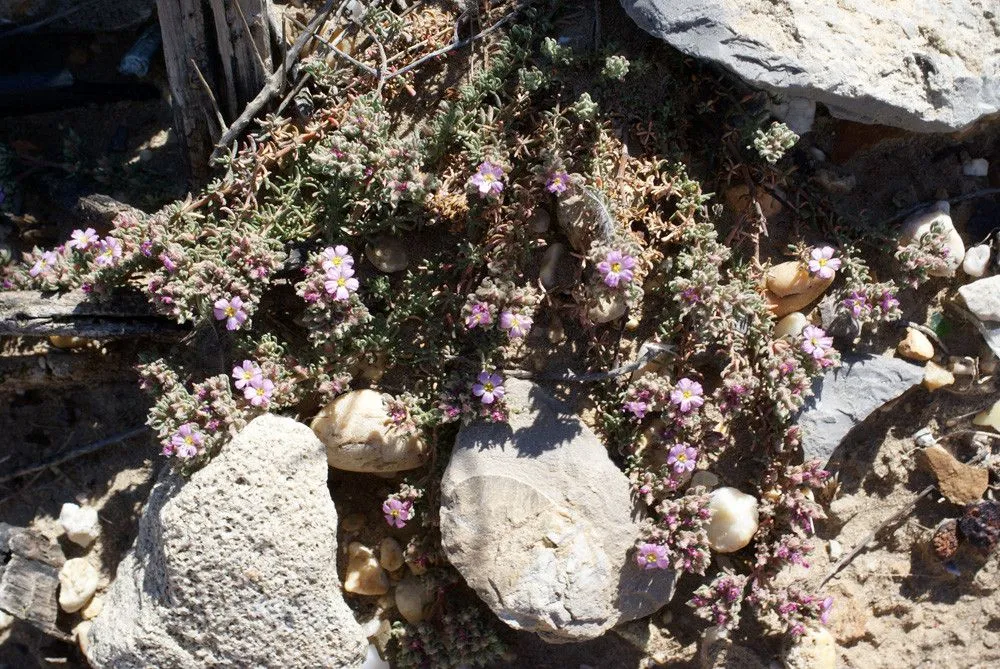
Author: L.
Bibliography: Sp. Pl.: 331 (1753)
Year: 1753
Status: accepted
Rank: species
Genus: Frankenia
Vegetable: False
Observations: Medit. to W. Siberia and Iran
The Hairy sea-heath, scientifically known as Frankenia hirsuta, is a resilient and widespread plant species found primarily in Mediterranean regions, extending its habitat range to Western Siberia and Iran. First documented by the renowned botanist Carl Linnaeus in 1753, this plant belongs to the Frankeniaceae family.
Hairy sea-heath is distinguished by its robust and hairy structure, which contributes to its common name. The plant exhibits a remarkable adaptability to various climatic conditions, thriving in arid and semi-arid environments. It often occupies coastal areas and saline soils, where other vegetation may struggle to survive.
Frankenia hirsuta’s morphological characteristics include small, densely packed leaves covered in fine hairs that help reduce water loss, a crucial adaptation for surviving in its typically harsh habitats. The plant’s flowers are petite yet attractively vibrant, often presenting shades of pink or white, adding to the visual diversity of the landscapes it inhabits.
Ecologically, Hairy sea-heath plays a significant role in its native regions. Its ability to stabilize the soil helps prevent erosion, particularly in coastal zones where sandy soils prevail. Moreover, it provides habitat and food for various insects and small animals, contributing to the local biodiversity.
In addition to its ecological importance, Frankenia hirsuta has caught the interest of botanists and horticulturists alike, due to its hardiness and decorative potential. Its unique appearance and resilience make it a valuable plant for rock gardens and other areas where conventional plants may not thrive.
Overall, the Hairy sea-heath is a remarkable example of nature’s adaptability and resilience, offering both ecological benefits and aesthetic values in the diverse regions it populates.
Deu: behaarte frankenie
Eng: hairy sea-heath
En: Hairy Sea-heath
Ar: هيشب (هِيشب)، هميشه (هِميشه)
Ca: Franquènia intermèdia
Fr: Frankénie hirsute
De: Behaarte Frankenie
He: פרנקניה שעירה
It: Erba-franca pelosa
: Hairy sea-heath
© copyright of the Board of Trustees of the Royal Botanic Gardens, Kew.
© copyright of the Board of Trustees of the Royal Botanic Gardens, Kew.
© copyright of the Board of Trustees of the Royal Botanic Gardens, Kew.
Taken Apr 15, 2017 by Tela Botanica − Liliane ROUBAUDI (cc-by-sa)
Taken May 17, 2014 by Tela Botanica − Liliane Roubaudi (cc-by-sa)
Taken May 17, 2014 by Tela Botanica − Liliane Roubaudi (cc-by-sa)
Taken May 17, 2014 by Tela Botanica − Liliane Roubaudi (cc-by-sa)
Taken May 17, 2014 by Tela Botanica − Liliane Roubaudi (cc-by-sa)
Taken May 17, 2014 by Tela Botanica − Liliane Roubaudi (cc-by-sa)
Taken Apr 30, 2018 by Tela Botanica − Liliane ROUBAUDI (cc-by-sa)
Taken May 20, 2018 by Ricardo Aperador Rubio (cc-by-sa)
Taken Mar 10, 2020 by annie pouchin (cc-by-sa)
Taken May 17, 2014 by Tela Botanica − Liliane Roubaudi (cc-by-sa)
Taken May 17, 2014 by Tela Botanica − Liliane Roubaudi (cc-by-sa)
Taken May 17, 2014 by Tela Botanica − Liliane Roubaudi (cc-by-sa)
Taken May 17, 2014 by Tela Botanica − Liliane Roubaudi (cc-by-sa)
Taken May 17, 2014 by Tela Botanica − Liliane Roubaudi (cc-by-sa)
Taken May 3, 2014 by Tela Botanica − Liliane Roubaudi (cc-by-sa)
Taken Jan 1, 1970 by Photoflora – L’Abbé COSTE (©)
Taken May 15, 2014 by Photoflora – Benoit BOCK (©)
Taken Apr 3, 2004 by Tela Botanica − Errol Vela (cc-by-sa)
Taken May 10, 2013 by Tela Botanica − Brigitte GENTIT (cc-by-sa)
Ph maximum: 8.0
Ph minimum: 7.5
Light: 9
Atmospheric humidity: 3
Bloom months: [‘jun’, ‘jul’, ‘aug’]
Soil nutriments: 6
Soil salinity: 6
Family: Myrtaceae Author: (F.Muell.) K.D.Hill & L.A.S.Johnson Bibliography: Telopea 6: 402 (1995) Year: 1995 Status:…
Family: Rubiaceae Author: Pierre ex A.Froehner Bibliography: Notizbl. Bot. Gart. Berlin-Dahlem 1: 237 (1897) Year:…
Family: Sapindaceae Author: Koidz. Bibliography: J. Coll. Sci. Imp. Univ. Tokyo 32(1): 38 (1911) Year:…
Family: Asteraceae Author: A.Gray Bibliography: Pacif. Railr. Rep.: 107 (1857) Year: 1857 Status: accepted Rank:…
Family: Fabaceae Author: Medik. Bibliography: Vorles. Churpfälz. Phys.-Ökon. Ges. 2: 398 (1787) Year: 1787 Status:…
Family: Aspleniaceae Author: (Cav.) Alston Bibliography: Bull. Misc. Inform. Kew 1932: 309 (1932) Year: 1932…